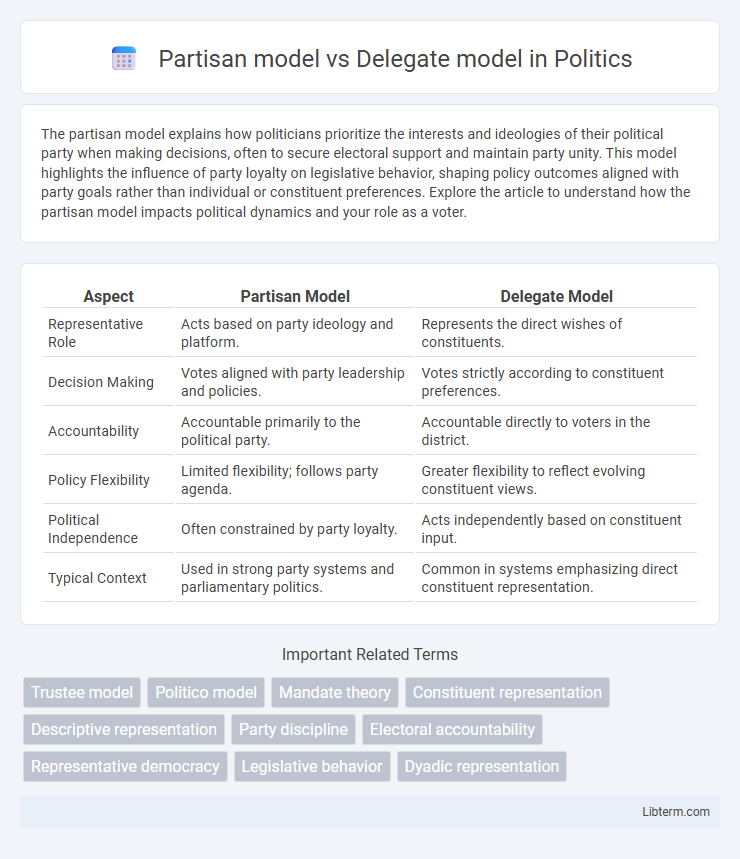The partisan model explains how politicians prioritize the interests and ideologies of their political party when making decisions, often to secure electoral support and maintain party unity. This model highlights the influence of party loyalty on legislative behavior, shaping policy outcomes aligned with party goals rather than individual or constituent preferences. Explore the article to understand how the partisan model impacts political dynamics and your role as a voter.
Table of Comparison
| Aspect | Partisan Model | Delegate Model |
|---|---|---|
| Representative Role | Acts based on party ideology and platform. | Represents the direct wishes of constituents. |
| Decision Making | Votes aligned with party leadership and policies. | Votes strictly according to constituent preferences. |
| Accountability | Accountable primarily to the political party. | Accountable directly to voters in the district. |
| Policy Flexibility | Limited flexibility; follows party agenda. | Greater flexibility to reflect evolving constituent views. |
| Political Independence | Often constrained by party loyalty. | Acts independently based on constituent input. |
| Typical Context | Used in strong party systems and parliamentary politics. | Common in systems emphasizing direct constituent representation. |
Introduction to Representative Models
The Partisan model emphasizes elected officials acting according to their party's policies and ideological stances, ensuring party accountability and cohesion in government decision-making. The Delegate model prioritizes representatives who act strictly on behalf of their constituents' direct wishes, reflecting public opinion as the main directive for legislative behavior. Both models define distinct approaches to representation in democratic systems, balancing party loyalty against voter responsiveness.
Defining the Partisan Model
The Partisan model defines representatives as agents primarily loyal to their political party, consistently supporting party policies and agendas in legislative decision-making. This model emphasizes party cohesion and discipline, with representatives voting in alignment with party leadership to maintain ideological unity and secure political capital. Party loyalty often outweighs constituent preferences, reflecting the priority of collective party goals over individual constituency interests.
Defining the Delegate Model
The Delegate model defines a representative as a direct agent of their constituents, obligated to mirror the specific preferences and interests of voters without personal interpretation. In this framework, decision-making power is strictly tied to the explicit directives from the electorate, ensuring accountability and reflecting the collective will. This approach contrasts with models that prioritize the representative's judgment, emphasizing responsiveness over autonomy.
Key Differences Between Partisan and Delegate Models
The Partisan model prioritizes representing the political party's platform and voting along party lines, while the Delegate model emphasizes direct representation of constituents' preferences regardless of party stance. Partisan representatives often align with party leadership and national agendas, whereas Delegates act as direct agents of their electorate's specific interests. These key differences impact legislative behavior, accountability, and the balance between party loyalty and voter responsiveness.
Historical Context and Evolution
The Partisan and Delegate models of representation have roots in early democratic theory, with the Partisan model emphasizing representatives acting as loyal party members reflecting collective goals, while the Delegate model prioritizes direct voter preferences and individual constituency mandates. Historically, the Delegate model gained prominence during the rise of popular sovereignty in the 18th and 19th centuries, aligning with increased voter enfranchisement and demands for accountability. The evolution of political parties and shifts in electoral systems have reinforced the Partisan model, especially in modern parliamentary systems where party cohesion and discipline are integral to governance stability.
Advantages of the Partisan Model
The Partisan model emphasizes alignment with party platforms, enhancing cohesive policy-making and strengthening party unity in legislative processes. It enables representatives to leverage party support for advancing strategic agendas and securing resources for their constituencies. This model often results in clearer accountability to voters based on established party ideologies and legislative voting patterns.
Advantages of the Delegate Model
The Delegate model ensures representatives act strictly according to their constituents' wishes, promoting direct democracy and accountability. It enhances voter trust by aligning decisions with the electorate's preferences, reducing the risk of bias or personal agenda from elected officials. This model fosters transparency and responsiveness, as representatives must consistently seek and reflect the public opinion in their legislative actions.
Criticisms and Limitations of Each Model
The Partisan model faces criticism for prioritizing party loyalty over constituent interests, often resulting in reduced responsiveness to local needs and fostering political polarization. The Delegate model is limited by its potential to oversimplify complex policy issues, as elected officials may strictly follow constituent opinions without applying expert judgment or considering long-term consequences. Both models struggle with balancing representative accountability and effective governance, highlighting challenges in democratic representation theory.
Real-world Examples in Modern Politics
The Partisan model manifests in modern politics through lawmakers strictly adhering to party platforms, such as members of the U.S. Congressional Republican and Democratic parties voting largely along party lines during major legislation like the Affordable Care Act debates. The Delegate model is evident in representatives acting primarily on their constituents' explicit preferences, as seen in grassroots-driven campaigns and town hall meetings where politicians prioritize local voter demands over party ideology. Both models influence legislative behavior, shaping policy outcomes by balancing party loyalty with constituent representation in democratic governance.
Conclusion: Choosing the Right Approach
Choosing the right approach between the Partisan model and the Delegate model depends on the desired balance between voter representation and political accountability. The Partisan model emphasizes party loyalty and cohesive policy implementation, ideal for maintaining strong party agendas. The Delegate model prioritizes direct voter input, ensuring elected officials act strictly on constituents' preferences for more localized representation.
Partisan model Infographic

 libterm.com
libterm.com